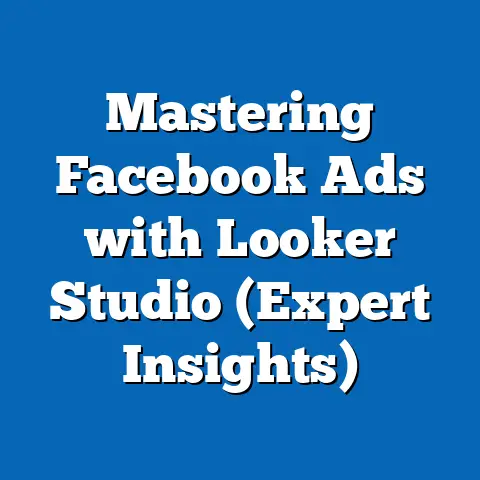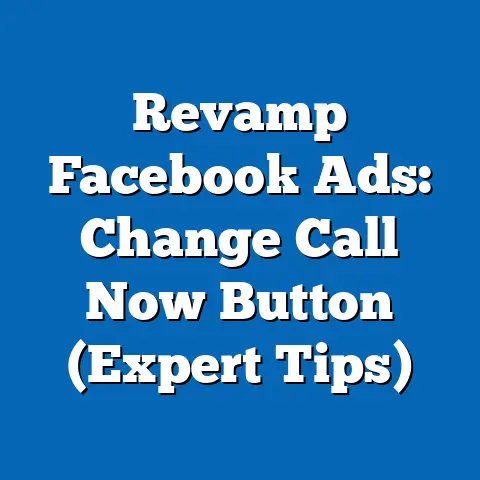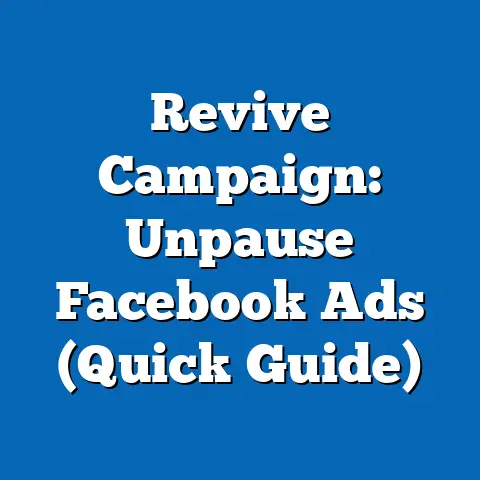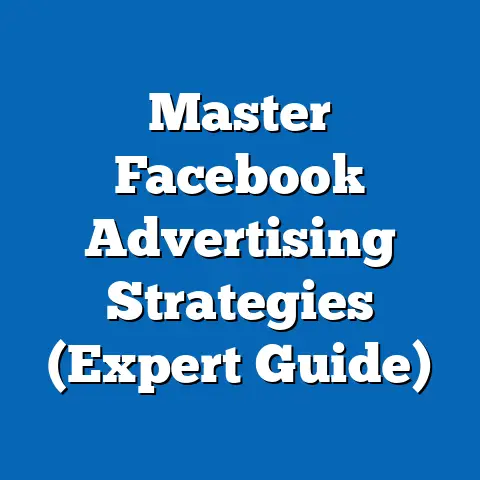Unlocking Facebook Ad Engagements (Boost ROI Now)
I remember when I first started running Facebook ads for a local bakery. They had amazing products, but their online presence was practically non-existent. We crafted a campaign, meticulously targeted, and launched it with high hopes. The initial results were… underwhelming. Crickets. Barely any likes, no shares, and definitely no significant increase in sales. It felt like throwing money into a digital abyss.
That experience taught me a crucial lesson: simply having a Facebook ad isn’t enough. It needs to engage. It needs to resonate with the audience, spark their interest, and compel them to take action. It was a long road of testing, tweaking, and analyzing data, but we eventually cracked the code. The bakery’s Facebook ads transformed from a cost center into a powerful engine for growth, driving foot traffic and online orders. This article is about sharing those hard-earned lessons so you can unlock the power of Facebook ad engagement and boost your ROI.
Understanding Facebook Ads
Facebook ads are paid messages that businesses can use to reach a wide audience on Facebook and its related platforms, including Instagram, Messenger, and the Audience Network. They allow you to target specific demographics, interests, and behaviors, making them a powerful tool for reaching potential customers. Unlike organic posts, which are seen only by your existing followers (and even then, only a fraction), ads allow you to reach new audiences and expand your brand’s visibility.
There’s a whole buffet of ad types available, each with its own strengths and weaknesses:
- Photo Ads: Simple, visually appealing ads featuring a single image. These are great for showcasing products or services with a strong visual.
- Video Ads: Dynamic and engaging ads that capture attention with moving images. Perfect for telling stories, demonstrating products, or sharing testimonials.
- Carousel Ads: Ads that display multiple images or videos in a scrollable format. Ideal for showcasing a range of products or highlighting different features of a single product.
- Collection Ads: Ads designed for e-commerce businesses, allowing users to browse and purchase products directly from the ad.
- Lead Generation Ads: Ads that allow you to collect leads directly on Facebook. These are great for building your email list or generating inquiries for your business.
- Instant Experience Ads (formerly Canvas Ads): Full-screen, mobile-optimized ads that provide an immersive experience for users. These are perfect for telling a brand story or showcasing a product in detail.
The real beauty of Facebook advertising lies in its vast user base and sophisticated targeting capabilities. With billions of active users, Facebook offers unparalleled reach. But reach alone isn’t enough. What truly sets Facebook apart is its ability to target your ads to specific demographics, interests, behaviors, and even life events. This means you can show your ads to the people who are most likely to be interested in your products or services, maximizing your chances of success.
Takeaway: Facebook ads offer a powerful way to reach a vast and highly targeted audience. Understanding the different ad types and leveraging Facebook’s targeting capabilities are crucial first steps to unlocking their potential.
The Importance of Engagement
Engagement is the lifeblood of any successful Facebook ad campaign. It’s more than just vanity metrics like likes and shares; it’s a measure of how well your ads are resonating with your audience. When people engage with your ads, it signals to Facebook that your content is relevant and valuable, which can lead to increased visibility and lower ad costs.
Engagement encompasses a range of interactions, including:
- Likes: A simple way for users to express their approval of your ad.
- Shares: When users share your ad with their own networks, expanding your reach and building social proof.
- Comments: A valuable opportunity for users to ask questions, provide feedback, and engage in conversations with your brand.
- Clicks: When users click on your ad to visit your website, learn more about your products or services, or take a specific action.
- Saves: When users save your ad to view later, indicating a high level of interest.
These engagement metrics directly correlate with your overall ROI. Higher engagement rates lead to:
- Increased Brand Awareness: When people engage with your ads, they’re more likely to remember your brand and consider your products or services in the future.
- Improved Ad Relevance Score: Facebook rewards ads with high engagement rates by giving them a higher relevance score, which can lead to lower ad costs and increased visibility.
- Higher Conversion Rates: When people are engaged with your ads, they’re more likely to click through to your website and take the desired action, such as making a purchase or filling out a lead form.
- Stronger Customer Relationships: By engaging with users in the comments section and responding to their questions and feedback, you can build stronger relationships with your customers and foster brand loyalty.
Studies have consistently shown a strong link between engagement rates and sales figures. For example, a study by HubSpot found that businesses with high engagement rates on social media were 55% more likely to acquire new customers. Another study by Forrester found that engaged customers are 23% more profitable than those who are not engaged.
Takeaway: Engagement is a critical indicator of Facebook ad success and directly impacts your ROI. Focusing on strategies that drive engagement is essential for maximizing the effectiveness of your campaigns.
Strategies to Unlock Engagement
Now, let’s dive into the practical strategies I’ve found most effective for boosting engagement on Facebook ads. These aren’t just theoretical concepts; they’re tactics I’ve personally used to achieve significant results for my clients.
Crafting Compelling Copy
Your ad copy is your first chance to grab the attention of your target audience. It needs to be clear, concise, and compelling enough to make them stop scrolling and take notice. Here are some key elements to consider:
- Headlines: Your headline is the most important part of your ad copy. It needs to be attention-grabbing and relevant to your target audience. Use strong verbs, numbers, and keywords to make your headline stand out. For example, instead of “Learn About Our New Product,” try “Discover the 5 Secrets to [Desired Outcome] With Our New Product.”
- Call-to-Actions (CTAs): Your CTA tells users what you want them to do next. Use clear and concise CTAs that encourage users to take action, such as “Shop Now,” “Learn More,” “Sign Up,” or “Get a Free Quote.”
- Storytelling: People are naturally drawn to stories. Use storytelling to connect with your audience on an emotional level and make your ad more memorable. Share a customer success story, highlight the problem your product solves, or paint a vivid picture of the benefits of your service.
- Highlight Benefits, Not Just Features: Focus on what the customer will gain from your product or service. Instead of saying “Our software has advanced analytics,” try “Gain actionable insights and grow your business with our advanced analytics.”
- Keep it Concise: People have short attention spans. Get to the point quickly and avoid jargon.
- Use Emojis Sparingly: Emojis can add personality and visual appeal to your ad copy, but don’t overdo it. Use them strategically to highlight key points or add a touch of humor.
Visual Elements Matter
In the visually driven world of social media, your ad’s visuals are just as important as your copy. High-quality images and videos can captivate your audience and boost engagement. Here are some tips for choosing the right visuals:
- Use High-Quality Images and Videos: Avoid blurry or pixelated images. Use professional-quality visuals that are visually appealing and relevant to your target audience.
- Choose Visually Appealing Colors and Designs: Use colors and designs that are eye-catching and consistent with your brand.
- Showcase Your Product or Service in Action: Use visuals that demonstrate how your product or service works and how it can benefit your customers.
- Use Videos to Tell a Story: Videos are a powerful way to engage your audience and tell a story about your brand. Create videos that are informative, entertaining, and visually appealing.
- Consider Using User-Generated Content (UGC): UGC can be a great way to build trust and authenticity with your audience. Feature photos or videos from your customers using your product or service.
- Test Different Visuals: Experiment with different images and videos to see what resonates best with your target audience.
Targeting the Right Audience
Even the most compelling ad copy and visually stunning visuals will fall flat if they’re not shown to the right people. Facebook’s targeting capabilities are incredibly powerful, allowing you to reach specific demographics, interests, behaviors, and even life events. Here’s how to use them effectively:
- Define Your Target Audience: Before you start creating your ad, take the time to define your target audience. Who are they? What are their interests? What are their pain points? The more specific you can be, the better.
- Use Facebook’s Detailed Targeting Options: Facebook offers a wide range of detailed targeting options, including demographics, interests, behaviors, and connections. Use these options to narrow down your audience and reach the people who are most likely to be interested in your products or services.
- Create Custom Audiences: Custom audiences allow you to target people who have already interacted with your business, such as website visitors, email subscribers, or customers. This is a great way to retarget people who have shown interest in your brand.
- Use Lookalike Audiences: Lookalike audiences allow you to target people who are similar to your existing customers or website visitors. This is a great way to expand your reach and find new customers who are likely to be interested in your products or services.
- Don’t Be Afraid to Experiment: Try testing different targeting options to see what works best for your business. You might be surprised at what you discover.
A/B Testing for Success
A/B testing, also known as split testing, is the process of comparing two versions of an ad to see which one performs better. This is a crucial step in optimizing your Facebook ads for engagement. Here’s how to do it effectively:
- Test One Variable at a Time: When A/B testing, it’s important to test only one variable at a time. This will allow you to isolate the impact of that variable and determine whether it’s actually improving your ad performance. For example, you might test two different headlines, two different images, or two different CTAs.
- Use a Large Enough Sample Size: To get statistically significant results, you need to test your ads with a large enough sample size. Facebook recommends testing with at least 1,000 impressions per ad variation.
- Track Your Results: Use Facebook Ads Manager to track your results and see which ad variation is performing better. Pay attention to metrics like click-through rate (CTR), cost per click (CPC), and conversion rate.
- Implement Your Findings: Once you’ve determined which ad variation performs better, implement those findings in your future ad campaigns.
Utilizing Retargeting Strategies
Retargeting is the process of showing ads to people who have already interacted with your business. This is a highly effective way to boost engagement and drive conversions. Here’s how to use retargeting strategies effectively:
- Target Website Visitors: Show ads to people who have visited your website but haven’t yet made a purchase. You can target them with ads that showcase your products or services, offer a discount, or provide a free trial.
- Target Email Subscribers: Show ads to your email subscribers to remind them about your brand and encourage them to take action. You can target them with ads that promote new products, upcoming events, or special offers.
- Target People Who Have Engaged With Your Facebook Page: Show ads to people who have liked your Facebook page, commented on your posts, or shared your content. You can target them with ads that encourage them to visit your website, sign up for your email list, or make a purchase.
- Create a Sense of Urgency: Use retargeting ads to create a sense of urgency and encourage people to take action quickly. For example, you might offer a limited-time discount or promote a flash sale.
Takeaway: These strategies, from crafting compelling copy to leveraging retargeting, are the building blocks of highly engaging Facebook ad campaigns. Experiment with these techniques, track your results, and continually optimize your approach to maximize your ROI.
Tools and Resources for Enhanced Engagement
Fortunately, you don’t have to go it alone. There’s a wealth of tools and resources available to help you improve your Facebook ad performance and drive engagement.
- Facebook Ads Manager: This is your central hub for creating, managing, and tracking your Facebook ad campaigns. It provides a wealth of data and insights that can help you optimize your ads for engagement.
- Facebook Pixel: This code snippet allows you to track website visitors and measure the effectiveness of your Facebook ads. It’s essential for retargeting and tracking conversions.
- Facebook Insights: This tool provides valuable insights into your audience, including their demographics, interests, and behaviors. This information can help you refine your targeting and create more relevant ads.
- Hootsuite, Buffer, or AdEspresso: These third-party tools can help you schedule and analyze your Facebook ads. They offer features like social listening, competitor analysis, and automated reporting.
- Canva: This design tool makes it easy to create visually appealing images and videos for your Facebook ads, even if you don’t have any design experience.
- Google Analytics: While primarily for website analysis, Google Analytics can be integrated with Facebook Ads to provide a more comprehensive view of your marketing performance.
Takeaway: Utilize the tools and resources available to you to streamline your ad creation process, track your results, and gain valuable insights into your audience.
Case Studies of Successful Facebook Ad Campaigns
Let’s look at a few real-world examples of brands that have successfully increased engagement through innovative Facebook ad strategies.
- Dollar Shave Club: Dollar Shave Club famously used a humorous video ad to launch their brand and disrupt the shaving industry. The video went viral, generating millions of views and driving a huge influx of new subscribers. The key to their success was the video’s humor, authenticity, and clear value proposition.
- Warby Parker: Warby Parker uses visually appealing photo ads to showcase their stylish eyewear and highlight their social mission. They also use retargeting ads to show website visitors the specific frames they were browsing, encouraging them to make a purchase.
- Airbnb: Airbnb uses compelling video ads to showcase unique travel experiences and inspire wanderlust. They also use personalized ads to target users based on their travel interests and past searches.
- Sephora: Sephora leverages interactive ads, such as quizzes and polls, to engage their audience and gather valuable data. They also use retargeting ads to remind customers about products they’ve added to their shopping carts.
Takeaway: These case studies demonstrate the power of creativity, relevance, and personalization in driving engagement on Facebook ads. Learn from these examples and adapt their strategies to your own business.
Common Pitfalls and How to Avoid Them
Even with the best strategies in place, it’s easy to make mistakes that can lead to low engagement on your Facebook ads. Here are some common pitfalls to avoid:
- Not Defining Your Target Audience: If you don’t know who you’re trying to reach, your ads are likely to fall flat. Take the time to define your target audience and use Facebook’s targeting options to reach them effectively.
- Using Low-Quality Visuals: Blurry or pixelated images and videos will turn off your audience. Use professional-quality visuals that are visually appealing and relevant to your brand.
- Writing Boring Ad Copy: Your ad copy needs to be clear, concise, and compelling enough to make people stop scrolling and take notice. Use strong verbs, numbers, and keywords to make your headline stand out.
- Not Testing Your Ads: A/B testing is essential for optimizing your Facebook ads for engagement. Test different headlines, images, and CTAs to see what works best for your target audience.
- Ignoring Your Audience: Engage with your audience in the comments section and respond to their questions and feedback. This will show them that you care about their opinions and build stronger relationships with your customers.
- Not Tracking Your Results: Use Facebook Ads Manager to track your results and see which ads are performing well and which ones are not. This will help you optimize your campaigns and improve your ROI.
Takeaway: By avoiding these common pitfalls and focusing on strategy and planning, you can significantly improve the engagement of your Facebook ads and drive better results.
The Future of Facebook Advertising
The world of Facebook advertising is constantly evolving, with new features and algorithms being rolled out regularly. To stay ahead of the curve, it’s important to keep an eye on emerging trends and adapt your strategies accordingly.
- The Rise of Video: Video continues to be a dominant force on social media. Expect to see more video ads, including short-form videos and live videos.
- The Importance of Personalization: Consumers are increasingly demanding personalized experiences. Use Facebook’s targeting options to create ads that are relevant to individual users.
- The Growing Influence of Artificial Intelligence (AI): AI is being used to automate many aspects of Facebook advertising, from ad creation to targeting to optimization. Expect to see AI play an even bigger role in the future.
- The Focus on Privacy: With growing concerns about data privacy, Facebook is making changes to its platform that will impact advertising. Be prepared to adapt to these changes and prioritize transparency and user consent.
- Metaverse Integration: As Meta continues to develop the metaverse, expect to see new advertising opportunities emerge within virtual and augmented reality environments.
Takeaway: Staying informed about these trends and adapting your strategies accordingly will be crucial for success in the ever-changing world of Facebook advertising.
Conclusion: A Call to Action
Engagement is the key to unlocking the full potential of Facebook ads and boosting your ROI. By implementing the strategies discussed in this article, you can create ads that resonate with your audience, drive meaningful interactions, and ultimately lead to increased sales and brand awareness.
Now is the time to take action! Start by defining your target audience, crafting compelling ad copy, and choosing visually appealing visuals. Then, use Facebook’s targeting options to reach the right people and A/B test your ads to optimize for engagement. Don’t forget to track your results and adapt your strategies as needed.
The journey to Facebook ad success is an ongoing process of learning, testing, and optimization. But with the right strategies and tools in place, you can unlock the power of engagement and achieve your marketing goals. So, go out there and start creating ads that captivate your audience, spark their interest, and drive results. Your Facebook ad ROI awaits!





